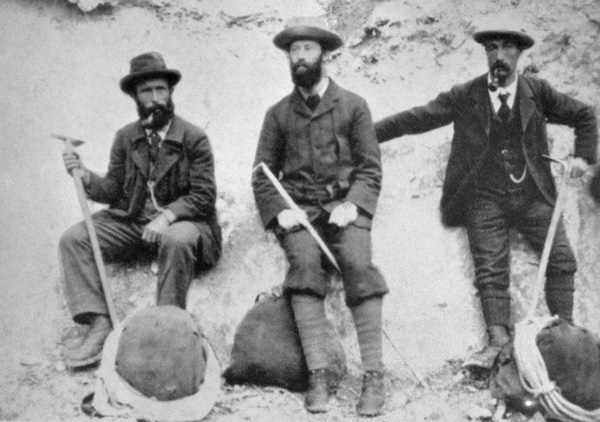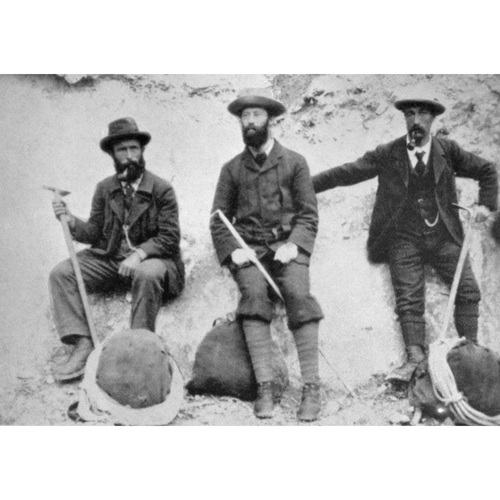
Source: Link
OUTRAM, Sir JAMES, Church of England clergyman, mountaineer, author, businessman, militia officer, and Orangeman; b. 13 Oct. 1864 in London, England, eldest son of Sir Francis Boyd Outram and Jane Anne Davidson; m. 17 May 1921 Lillian Mary Balfour in Montreal; they had no children; d. 12 March 1925 in Victoria.
Public distinction marked the family legacy that James Outram inherited. His paternal grandfather, Lieutenant-General James Outram, was created a baronet for outstanding service in the Indian Mutiny, and his father also distinguished himself in the military. Outram’s clerical career reveals the extent of his own drive. A graduate of Pembroke College, Cambridge (ba 1888, ma 1893), he was ordained deacon in 1889 and priest in 1890. He was curate of Holy Trinity Church in Hampstead (London) and then of Thorpe in Norfolk; from 1896 he was vicar of St Peter’s, Ipswich. In 1900 he suffered a mental breakdown from overwork.
Mountain climbing was the cure, and making first ascents of Canadian peaks became Outram’s passion. He began with routine climbs in the Swiss Alps and, in 1900 with his brother William, in the Canadian Rocky Mountains, where significant numbers of serious mountaineers had begun climbing for recreation, rather than for professional surveying or scientific work, after the completion of the Canadian Pacific Railway in 1885. Then, during the summers of 1901 and 1902, Outram made spectacular ascents of some of the highest unclimbed peaks in the Rockies. In 1901 he accompanied the CPR–sponsored party of Edward Whymper, the English mountaineer famous for his disastrous first ascent of the pyramid-shaped Matterhorn in Switzerland. Whymper was expected to generate publicity for the CPR by making first ascents, taking photographs, and publishing accounts of his expedition. While he was exploring the Ice River valley and elaborating plans to climb Mount Goodsir, Outram was drawn to the unscaled Mount Assiniboine, at 11,875 feet the highest mountain in the Canadian Rockies south of the CPR. The peak’s appeal lay in its dramatic appearance, the technical challenge of its height, and the romantic grandeur associated with its designation as the “Matterhorn of North America.” Canadian guide and outfitter Tom Wilson, British climber John Norman Collie, and American climber Walter Dwight Wilcox had already spent years mapping and trail-breaking in the Rockies, and had made numerous attempts to climb Assiniboine. On 3 Sept. 1901, however, it was newcomer James Outram, aided by Banff outfitter Bill Peyto and two Swiss guides, who succeeded.
Outram’s accomplishment established his reputation as a serious and ambitious mountaineer. His sudden appearance in the field caused mountaineers who had a much longer history of exploration in the Rockies, and who had hoped to make the first ascent of Assiniboine themselves, to consider him presumptuous as well. This unfavourable impression was reinforced in 1902 when Outram continued to scale some of the highest summits yet conquered in the Rockies, including mounts (12,298 feet) and Forbes (11,855 feet). A Swiss guide assisted on many of these climbs; on others, Outram joined Collie’s party, to the dismay of some members. Outram also spent time with Arthur Oliver Wheeler during his survey of the Selkirk Mountain ranges in British Columbia.
After 1902 Outram disappeared from the field of serious mountaineering as abruptly as he had burst onto it. He made no further climbs of significance, but he continued a keen interest in the sport. He maintained a corresponding membership with the Boston-based Appalachian Mountain Club, and lectured on his climbs to meetings of the American Alpine Club and the Alpine Club of Canada, the latter formed in 1906. He wrote articles on mountaineering and a book, In the heart of the Canadian Rockies (London, 1905), an engaging travelogue and history. His writing reveals his sound grasp of mountaineering principles, considerable literary skill, and the fusion of his religious piety and his passion for nature. He hoped his book would draw others to the Rockies to see the “noblest of God’s monuments.” He became an honorary member of the ACC in 1907, and participated in its mountaineering camps and executive meetings.
From 1908 to 1911 Outram lived in Crescent, Colo. After succeeding to his father’s baronetcy in 1912, he moved to Vermilion, Alta, where he became involved in short-lived land development companies. He was too old for overseas duty in World War I, but in 1916–18, with the rank of major, he commanded Vermilion’s militia company and served as an instructor in the infantry school at Camp Sarcee in Calgary. In 1920 he settled in Calgary, where he worked at various business-related jobs. During his time there he married an old family friend, the daughter of Joseph Balfour of Athelstone House in Brighton, England, and became a fellow of the Royal Colonial Institute.
Outram was also a dynamic member of the Orange order. He had been initiated into the Vermilion lodge on 13 Oct. 1914, and his numerous positions over the years culminated in terms in 1918–21 as provincial grand master of Alberta. At the Orange convention of March 1919 he took the opportunity to reiterate the order’s opposition to both separate schools in Alberta and the use of languages other than English in public discourse. He was provincial grand secretary from 1921, but ill health forced him to resign in August 1924. The next year he went to Victoria, where he died of a stroke and was buried in Royal Oak Park Cemetery.
Outram’s impact in Canada revolved around his commitment to Orangeism and his climbing. Outram Memorial Lodge in Calgary and Mount Outram in Alberta are named after him. His published writings and few existing papers usually share credit with fellow climbers for successful ascents, though occasional remarks are self-deprecating to the point of immodesty. Many acquaintances and climbing peers found him aloof and class-conscious, and a number of mountaineers were alienated by his brash, single-minded pursuit of the most prestigious summits in the Rockies. At the same time, his outstanding record of first ascents, and his lecture tours and publications, boosted Canada’s image as one of the world’s few remaining wildernesses.
Sir James Outram is the author of “Two traverses” and “The first ascent of Mt. Assiniboine,” Alpine Journal (London), 19 (1900): 624–25 and 21 (1903): 102–14, as well as the book In the heart of the Canadian Rockies (London, 1905).
Jasper-Yellowhead Museum and Arch. (Jasper, Alta), 993.37 (Robson family fonds). Whyte Museum of the Canadian Rockies (Banff, Alta), AC0/19 (A. A. McCoubrey papers); M106 (J. Monroe Thorington fonds), /2, /136, /142, /156 (photocopies); M526 (John Davenall Turner papers); V396 (James Outram fonds). [The Jasper-Yellowhead and Whyte museums both have collections of photographs of or by Outram.]. [Review of In the heart of the Canadian Rockies] Athenaeum (London), 6 Jan. 1906: 13. Calgary Herald, 14 March 1925. [Review of In the heart of the Canadian Rockies], Nation (New York),14 Dec. 1905: 485. Times (London), 19 May 1921, 16 March 1925. Alpine Club of Canada, Constitution and list of members, 1907–11, 1920–22. [J.] B. Burke, A genealogical and heraldic history of the peerage and baronetage . . . , ed. A. P. Burke (97th ed., London, 1939). Canadian annual rev., 1919: 771. Canadian men and women of the time (Morgan; 1912). Dod’s peerage, baronetage, and knightage of Great Britain and Ireland for 1923 (London, 1923). [Review of In the heart of the Canadian Rockies], New York Times Saturday Review, 4 Nov. 1905: 753. R. W. Sandford, The Canadian Alps: the history of mountaineering in Canada (Banff, Alta, 1990). Who’s who and why, 1919/20. Who’s who in Canada, 1922, 1925/26.
Cite This Article
Siri Louie, “OUTRAM, Sir JAMES,” in Dictionary of Canadian Biography, vol. 15, University of Toronto/Université Laval, 2003–, accessed December 19, 2025, https://www.biographi.ca/en/bio/outram_james_15E.html.
The citation above shows the format for footnotes and endnotes according to the Chicago manual of style (16th edition). Information to be used in other citation formats:
| Permalink: | https://www.biographi.ca/en/bio/outram_james_15E.html |
| Author of Article: | Siri Louie |
| Title of Article: | OUTRAM, Sir JAMES |
| Publication Name: | Dictionary of Canadian Biography, vol. 15 |
| Publisher: | University of Toronto/Université Laval |
| Year of publication: | 2005 |
| Year of revision: | 2005 |
| Access Date: | December 19, 2025 |



